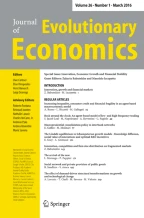Abstract.
Several researchers looking at the development of international export specialisation patterns have shown that there is a weak tendency for OECD countries to exhibit decreased levels of specialisation. This finding is in contrast to findings made by other authors, who found increasing technological specialisation. The first aim of this paper is to investigate whether these contradictory findings are due to a `real world' phenomenon, or whether the explanation is purely technical, by comparing the development of export specialisation to specialisation in terms of US patents, using the same methodology and level of aggregation. The second aim is to analyse the extent to which countries and sectors display stable specialisation patterns over time, also both in terms of exports and in terms of technology. The paper confirms that the OECD countries tend in general to become less specialised in terms of exports. The evidence is less conclusive with regard to technological specialisation, as the results are mixed in the sense that just about half of the countries tend to exhibit increased levels of specialisation, while the other half tend to exhibit lower levels of specialisation. In terms of country and sectoral stability of specialisation patterns, it can be concluded that both trade specialisation and technological specialisation patterns are path-dependent. In comparison, however, trade specialisation patterns are more stable than are technological specialisation patterns.
Similar content being viewed by others
Author information
Authors and Affiliations
Rights and permissions
About this article
Cite this article
Laursen, K. Do export and technological specialisation patterns co-evolve in terms of convergence or divergence? Evidence from 19 OECD countries, 1971–1991. J Evol Econ 10, 415–436 (2000). https://doi.org/10.1007/s001910000044
Issue Date:
DOI: https://doi.org/10.1007/s001910000044
